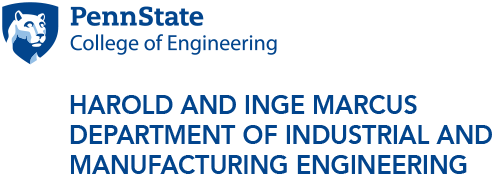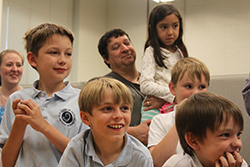
Second-grader Mary Patrick reacts to her twin brother Patrick’s attempts to place the head of a robot back on its body using motion-detection software.
Fueling imaginations
Penn Staters give local elementary students exposure to new STEM technologies
6/17/2016
UNIVERSITY PARK, Pa. — How long does it take to solve the Rubik’s Cube? An hour? A day? Perhaps longer?
Sean Davis, an information sciences and technology undergraduate student, managed to build a robot out of Legos and some computer coding software that can solve the iconic brainteaser in 90 seconds or less every time. And that time guarantee is regardless of how out of order those colored little squares are on the cube.
“The fastest robot that is built to solve the Cube can do it in just three seconds,” said Davis, whose comment drew gasps from the children and their parents.
Davis' robot was just one example of the capabilities computer coding has in the fields of robotics and engineering that was on display during a recent Penn State workshop attended by elementary students from Our Lady of Victory Catholic School (OLV).
The students visited the Data Analysis Technology Advancement (DATA) lab, which is run by Conrad Tucker, an assistant professor of engineering design and industrial engineering and an affiliate faculty member in the Department of Computer Science and Engineering.
Tucker and several of his students hosted the first- through fifth-graders who are enrolled in an after-school coding class at OLV.
Tucker gave an overview of what he and his students work on in his lab and showed examples of how gaming systems and other technologies can be put to use to help solve some of society’s biggest issues. He also gave the students time to interact personally with some of the equipment and addressed many of their questions pertaining to the use of robotics and machine learning in engineering.
“It is always rewarding to see the broader impacts of National Science Foundation-funded research being disseminated to the younger generation,” said Tucker. “They are the future and anything that I can do to inspire them makes everything that we do that much more rewarding. Their intellectual curiosity and level of insight pertaining to graduate level research gives me great hope and belief in our future scientists and leaders.”
Tucker demonstrated how devices that are used in some home gaming systems track the movements of people and how those same devices can be used to help others complete simple tasks. He recruited volunteers to come up and put their hands above a sensor while they attempted to reach for and place objects that were displayed via a computer on a projection screen.
Tucker also related how this same technology can be used to monitor patients who have—or may have—Parkinson’s disease, in order to see how a person’s tremors are progressing or how mobile they are.
Adam Mohammed, a computer science and engineering graduate student, demonstrated how he programmed his phone to make a robot he helped to build move around the room.
“It was interesting to see how machines can be coded and made to work with people,” said Becky Mignot, an OLV third-grader who attended the workshop. “I hadn’t really thought about coding in that way before so that was cool.”
Tucker and his students also gave the students the opportunity to try out the Oculus Rift virtual reality technology that is being used by Tucker and others at Penn State in a variety of ways, and in a number of disciplines.
“The virtual reality system and wearing the equipment was my favorite part,” said 10-year-old Isaac Keim. “It really felt like I was in a video game, which was so cool to see.”
The workshop was organized by Dan Finke, a research associate at the Applied Research Lab and an affiliate faculty member in the Harold and Inge Marcus Department of Industrial and Manufacturing Engineering.
Finke, who has a daughter that attends OLV, spoke with a group of parents last summer about how computers impact almost every aspect of daily life and how children are going to need to, at the very least, understand why and how computers operate.
As a result of that conversation, Finke and Julianna Little, a technology resource teacher for grades K-6 at OLV, initiated the creation of the coding class this year, called “An Introduction to Code,” and have seen tremendous interest from students who are eager to participate.
“Julianna runs a strong technology program at OLV and uses tools such as Code.org to give the students some hands-on experience at a very young age,” said Finke.
Little, who is also a middle school math teacher at OLV, and Finke run the six-week coding classes and are amazed at the enthusiasm the students have shown toward coding and just how quickly they are able to pick up the concepts.
“I am so grateful for the tremendous support Dan has provided for our program,” said Little. “His generosity and patience while giving up his own time to teach classes have allowed our students to have invaluable experiences. When the students have the chance to use their imagination and creativity, they find the perseverance to work through problems in order to reach their goals.”
The after-school class became so popular, in fact, that now two classes are offered: a beginners’ class, taught by Little, and an advanced class that Finke teaches.
“Most of the students joined the class to learn how to program video games, but there is so much more,” said Finke. “We wanted to give them more examples and models of ‘cool stuff’ that can be done with code to fuel their imaginations. It’s our hope that in a few short years, they will be STEM students developing the new technology that will undoubtedly have an even larger impact on our daily lives.”
Matt Dering, a computer science and engineering graduate student, and Kevin Lesniak, an industrial engineering graduate student, also assisted Tucker during the workshop.
View more images from the workshop in the Flickr album.








